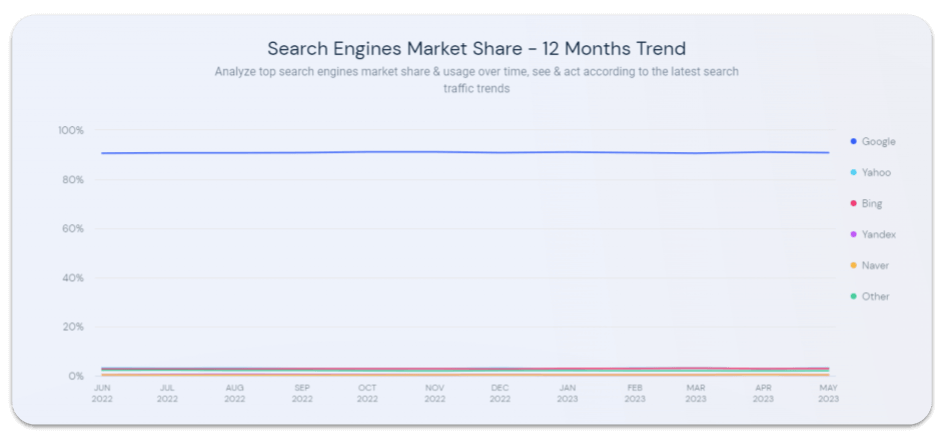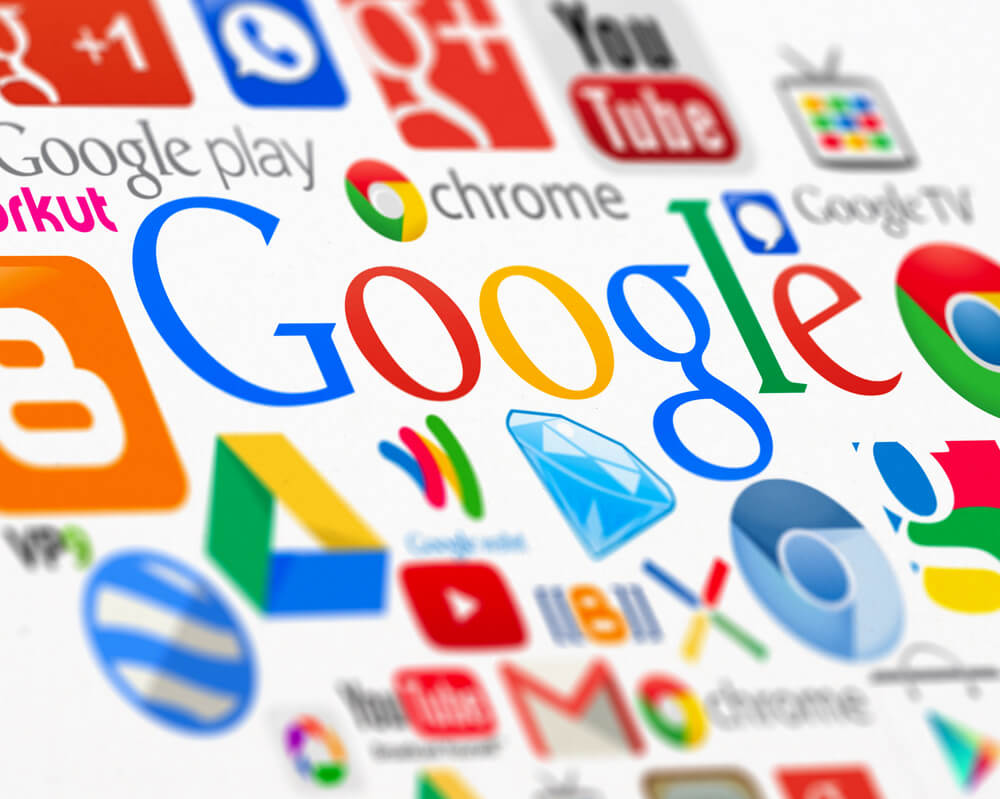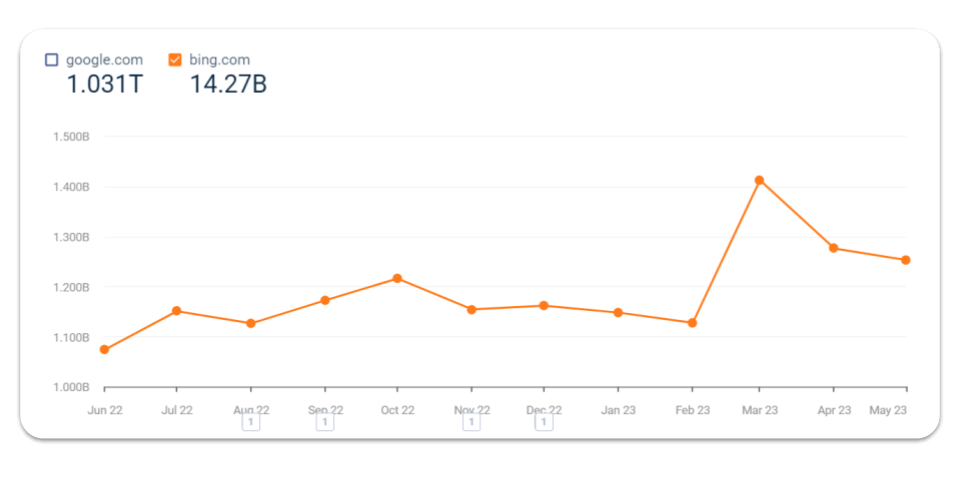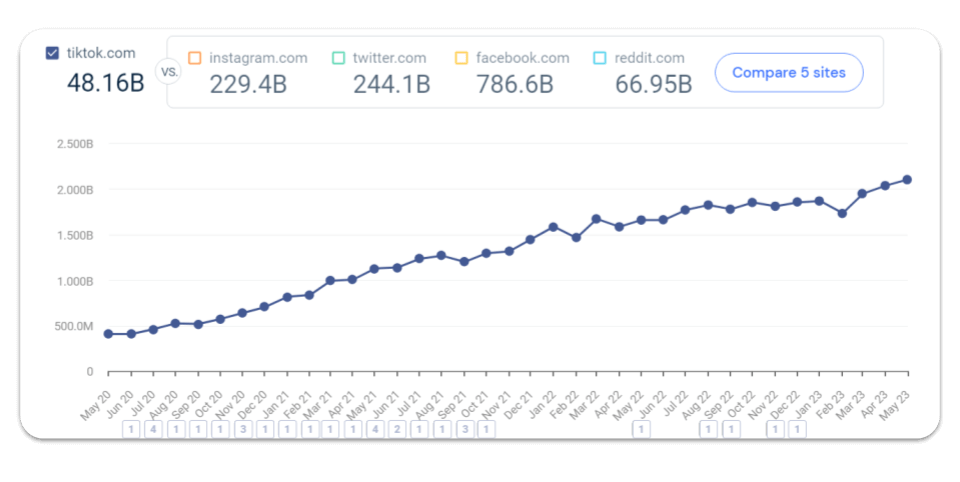5 Google Marketing Strategies You Can Implement Today

If Google is good at one thing (other than search of course) it’s marketing.
I mean…
If you look at Google’s market share you’ll notice that Google is still the undisputed king of search.
Over the last 12 months, Google got 1,03 trillion visits while perhaps Google’s biggest competitor Bing only got 14.27 billion visits.
What’s more…
Google as a company owns hundreds of products that are used by billions of people around the world.
Now, you might be wondering how Google managed to own this entire market.
Yes, this internet giant employs some of the most subtle, yet impressive marketing strategies out there.
Strategies that you can work into your own marketing tactics.
In this post, I’ll get into Google’s digital marketing strategy and answer the question, how does Google market its products?
And of course, I’ll get into some actionable takeaways you can apply to your business.
Here are five powerful marketing strategies you can implement in your business…
1. Great Marketing Starts With Great Products
Before I get into any of Google’s marketing strategies it’s important to realize that a business that has great marketing and a terrible offer will not succeed.
Because if your products are awful, your users will churn.
And even the best marketing strategy can’t fix that.
Because…
The goal of marketing is to notify your audience about your product. And, since your product is designed to solve a nagging problem, your marketing should show how your product scratches a proverbial itch.
This means a great marketing strategy is borne out of a great product. If your product doesn’t serve your prospects your marketing will fall flat.
And that means marketing starts with your product.
How Does Google Market its Products?
So, how does Google market its products so that they have such a massive user base?
The first step is to create an offer that is so useful that your audience can’t possibly live without it. (Then offer it for free and sell advertising space but more about this later.)
How does Google do this?
It comes down to one thing.
Massive user data.
User data enables Google to find valuable insights into what its users want and need. With these insights, Google creates numerous products that are designed to solve an array of problems users might have.
And…
When Google launches a product they prioritize the user long before thinking about monetization.
How do they do this?
Google puts massive resources into its products with a focus on innovation.
What’s more…
Google is constantly testing its products. As SEOs, we see Google constantly testing SERP features.
This means Google is slowly and consistently improving its products.
The net result is a commitment to continuous improvement and constant innovation based on user data.
User Data. Your Greatest Business Asset
Now let’s apply this to your business. How do you create products that are irresistible?
Take a page out of Google’s book. The key is user data.
Now you most likely don’t have the extensive user data that Google does. But if you have been in business for a while, you have something just as good.
A client base.
Let your clients tell you exactly what their pain points are and ask them to explain exactly how your business solves them.
The best way to do that is through an interview, but you can also glean many valuable insights from customer surveys or by talking to your sales team.
2. Differentiation Through Innovation, How Google Stands Out From the Crowd
In this crowded world of online media, it’s easy to get lost in the noise.
This means, as a company you must find a way to differentiate yourself from the crowd.
How does Google do this?
By consistently testing and improving, Google is constantly innovating and by moving fast.
And, by combining user data and innovation Google is easily able to stand out in the crowd as the market leader. Because Google’s innovation is designed to benefit one person.
You, the user.
And since innovation is at the heart of everything, it stands to reason that Google’s solution can help its users in ways that its competitors can’t.
Now this is a double-edged sword. Stay tuned and I’ll explain why.
Google’s Innovation Head Start
There is an interesting dynamic at play when you look at Google’s market dominance.
As I mentioned above, search engines slowly improve their systems over time. This is because as more users use the platform, the search engine uses user data to improve its results.
Now if you think about it, Google started in 1999 while Bing first went live in 2009.
What’s more, Google was focused on organizing the world’s information to make it universally accessible and useful. This has always been Google’s primary objective.
Microsoft on the other hand was focused on other things, like Windows and Office.
This means Google puts the majority of its resources into its search engine.
The result?
Google was gathering useful information long before Bing even existed.
This means it’s almost impossible for other search engines to beat Google at the innovation game.
Because…
More innovation brings more users. More users means more user data. More user data means better innovation. And the cycle continues.
Google’s dominance is inevitable.
Except when it isn’t.
How to Dethrone the King – Innovations From Left Field
Now, as I mentioned above, Google’s main point of differentiation in the market is its innovation. As I mentioned before it’s almost inevitable that Google will remain the biggest innovator because of its user data.
But…
There is more than one way to innovate.
For instance…
When Bing included an AI chatbot in its search results, Google was completely unprepared. Google has always avoided using too much generative AI in its search engine.
And, when Bing takes the lead as the innovator, it chips away at Google’s uniqueness. We have seen Bing making inroads into Google’s market share.
This could very well be the reason Google is now leaning so heavily into adding generative AI into its search results.
We saw a similar pattern in 2020. That’s when Google added Short Video carousels to YouTube as well as in Google Search. Was that a reaction to the new up-and-coming short video platform TikTok?
As you can see TikTok’s meteoric rise as a short video platform.
What does all this mean to your business?
How To Find Your Point of Differentiation
There is a big takeaway you can apply to your business.
Firstly go back to your product. If you conducted the client interviews and surveys as I mentioned above, you have insight into exactly what your client wants and needs.
If you go deep enough into this you might uncover something that your competitors have not yet discovered.
When this happens, you’ve found an opportunity to serve your users in ways that no one has thought of before.
You can use that as your unique selling point.
3. Create a Quality User Experience – How Google Creates a Win-Win Situation
As I mentioned above, Google is constantly using user data to improve its products. The main point of all of this innovation is to improve the quality of the user experience.
Because Google creates products that its users simply can’t live without.
Take Google Search as an example.
Google has always attempted to create the best user experience.
We see this in its algorithm updates and systems.
There are systems designed to understand the intent of the user’s queries and find content that directly speaks to that intent. This makes finding specific content simple and easy.
Other systems are designed to demote spam content. Some demote bad product reviews.
If you look at it, each system exists to serve the user.
The better Google can do that, the happier its users will be. The happier its users are, the more people use the platforms.
That means Google sells more advertising space. But, even Google’s ads platform is designed to improve the user experience. Ads that are deemed to be of low quality or not relevant are demoted in the rankings no matter how much the advertiser bids.
The net result?
Everyone is happy.
Firstly the user is happy because everything is designed to be helpful. Even the ads.
The advertiser is happy because their ads are served to the right users.
And Google is laughing all the way to the bank.
4. Google’s Growth Strategy – It’s Freemium-For-All
The vast majority of Google’s products are free.
Google does this either through freemium offers or by monetizing its massive audience by selling ad space.
Why do you think Google does this?
Google gets you hooked and you have no choice but to go on using their products.
By offering a free and open platform Google draws in users without any concerns, as there is absolutely no loss in giving Google search a try.
Free means zero risk.
And, as I mentioned above, Google’s products are designed with the user in mind.
This means, that once you start using them, you don’t want to stop.
This trend continues today, just look at all of the SERP features Google provides for free. Tons and tons of user-oriented information within Knowledge Panels, Answer Boxes, and Featured Snippets, all for the user, all for free.
The result?
Google has grown massively over the years, resulting in substantial market penetration and a massive market share.
And, if you include how Google has a great product designed to be helpful to almost any user, a massive user base means one thing.
A massive user base in almost any vertical.
From international search to local search, ecommerce to informational search, the results are relevant and useful.
This means almost anyone can benefit from Google search.
And I’m not only talking about the user. Because the more the user gets from Google Search the more appealing it is to advertisers.
How Free Access Can Apply to Your Business
Now, this exact model doesn’t work for every company since not every business can be supported via advertising. But, almost any business can benefit from a free offer.
Because open and free access is powerful.
And free or freemium is a small commitment offering little to low resistance.
Because…
You can’t retain that which you don’t have yet. This is precisely why a free trial is pertinent, it sets you up for conversion.
Free offers can benefit your business in two ways.
- It helps build relationships with your potential customers
- It helps reduce friction
Use Free Offers Turn Ice Cold Users Into Warm Leads
As marketers, we all know how many touchpoints it takes to generate a sale. The reason is it takes time to build trust with your audience.
Offering something for free helps to build a feeling of trust and reciprocity.
In other words, it builds a relationship.
And, we generally do business with people or companies that we know, like, and trust.
You can easily do this even if you don’t have a free freemium offer like Google does. Because as a business you should position yourself as an expert.
This means if you don’t have a free product, you might want to share free resources related to your service.
You can share things like:
- Free courses
- Free workshops
- Free templates and tools
The options are almost endless.
Now, when you offer something free and more importantly if your audience finds your free offer extremely useful, you build a relationship with them.
The deeper the relationship goes, the more likely they are to do business with you in the future.
Use Free Offers to Reduce Friction
A second benefit of a free offer is, that free offers reduce friction.
People are often set in their ways. They have a product that they’ve been using for years.
How do you convince them that your product can serve them better?
Free access solves that problem.
Because…
People have general anxiety when it comes to change, there’s a certain distrust of something “new.”
For instance, my mother-in-law eats Peter Pan peanut butter religiously. Is Peter Pan really worth the extra $1.29 it costs to buy instead of the generic brand? Probably not (I prefer natural peanut butter anyway!)
Why does my mother-in-law eat Peter Pan peanut butter?
Because she is comfortable with what she knows and there is anxiety in trying something new.
Well, guess what, many of your potential customers are like my mother-in-law, they’re using your competitor’s service or product not because it’s really better, but because it’s comfortable.
Dealing with this inertia will help you find new warm leads. Warm leads that can easily turn into customers.
One of the best ways is to pull “a Google” and offer an expansive free trial.
The old saying that first impressions are the most important holds true here, you need to offer a substantial look at your service or product.
By doing so you can effectively level the psychological playing field by giving potential customers a look at what you have to offer that isn’t tainted by any anxiety of leaving behind the familiar.
Once you’ve done that, then you can think about conversions.
5. Foster A Culture of Conversation
Google takes the phrase Let’s give them something to talk about to a whole new level.
A quick look at the “search industry” is all it takes to see that the most discussed topic is none other than Google itself. What the search engine has so brilliantly done is to create a culture of conversation.
Within the SEO and SEM industries, Google is not only an abstract corporate concept, it is its “Googlers” (i.e. John Mueller, Gary Illyes, etc.).
Google has literally given its company human faces that literally drive the conversation.
By opening up itself in this way to the public, or in specific to its industry voices, Google has created an interactive environment. The obvious upshot is that all of this talking centers on one thing… Google!
On the other hand, when Google (via its Googlers) speaks, the communication is interactive and aimed specifically at a certain community (i.e. the SEO community). This results in a meaningful conversation that gives users a sense of belonging.
Because…
We all want to be part of a community, to be heard, and to be addressed.
Creating a Sense of Community within the Context of Your Business
Chances are you and your company are not Google and people are not hanging off every word you have to say… and that’s fine.
Not generating such prolific buzz as the search engine mega-giant doesn’t mean you shouldn’t capitalize on the sense of belonging communication brings with it. Here are some simple ways to do that.
Don’t be Afraid to Get a Little Personal
Put your face out there (or someone from your company). In many industries, the days of a complete corporate look are long gone, people want to see a face.
This means you should embrace social media and content marketing.
Go with it.
Everyone has their own comfort zone so the possibilities are in a sense limited to your own creativity and comfort level.
By way of example, you could certainly decide to use the same Twitter account for your personal and business Tweets, a trend I see happening more and more as time goes on. Doing so would give your customers a small glimpse into you as a person.
Along the same lines, you could certainly post some of your office doings to social media in order to create a more inclusive and personal feel.
The offering of webinars on industry trends and topics would be a perfect way to introduce a personal element into your business. Again, there are endless ways to go about this, it all depends on you.
Don’t be afraid to share your story.
Speak Directly to Your Customers
Remember that your customers are people. And people like to communicate with other people, rather than with a faceless corporate entity.
This means trying to communicate the same way you would speak to a person sitting in front of you.
That means forget terms like “users” or “consumers” and start addressing your customers as ‘you’.
This will make your business seem more “human” and relatable.
What Google’s Marketing Strategy Means to Your Business
As you can see Google’s strategies are not only powerful, but almost any business can use them. The key is to adapt them to your specific situation.
For instance, first, make sure that you have an irresistible offer. Although you might not figure out what that is on your first day of business, try to gather user data. Your most powerful user data comes in the form of customer surveys or better yet, customer interviews.
Once you’ve figured out what your customers really want, make sure that your business gives them exactly what they want and need.
You can use that to differentiate and make your business stand out from the crowd. Make sure to tell your story in all of your communications including landing pages, email communications, etc.
Plan for growth by sharing free resources. And while you are at it, use your user data to create free resources that scratch an itch that your users have and create meaningful relationships with them.
FAQs
What is the concept behind Google’s Marketing?
In a nutshell, Google’s marketing concept includes growing a massive and diverse captive audience by providing relevant and useful information for almost any topic. Google’s primary goal is to connect people with the information they seek by organizing and making it accessible through its search engine. With such a large and diverse audience Google is able to sell advertising space for almost any vertical.
Why are Google Ads so successful?
Google Ads has been successful over the years because Google Search was designed with the user in mind. This applies to all aspects of the search engine including search ads. That means Advertisers have to produce quality ads that are highly relevant to the user’s search query. This means from a user perspective the ads are a part of the search experience and even add to the experience.
What are the 7Ps of marketing Google?
Google’s marketing strategy is often analyzed using the traditional 7Ps marketing mix framework, which includes:
- Product: Google offers a wide range of products and services, including its core search engine, and more.
- Price: While many of Google’s products and services are free for users, the company generates revenue primarily through its advertising platform, Google Ads.
- Place: Google operates globally, making its products and services available across various platforms and devices.
- Promotion: Google uses various promotion strategies to raise awareness and attract users and advertisers, including online advertising, search engine optimization (SEO), content marketing, and more.
- People: Google emphasizes hiring and retaining talented employees who drive innovation, develop new products, improve algorithms, provide customer support, and more.
- Process: Google’s marketing processes involve continuous improvement of its algorithms, search ranking factors, and advertising platform.
- Physical Evidence: Although Google primarily operates in the digital realm, it has physical evidence in the form of its data centers, hardware devices like Google Pixel smartphones and Nest smart home products, and more.
Your full marketing toolkit for a winning strategy
The ultimate solution to help you build the best digital strategy















